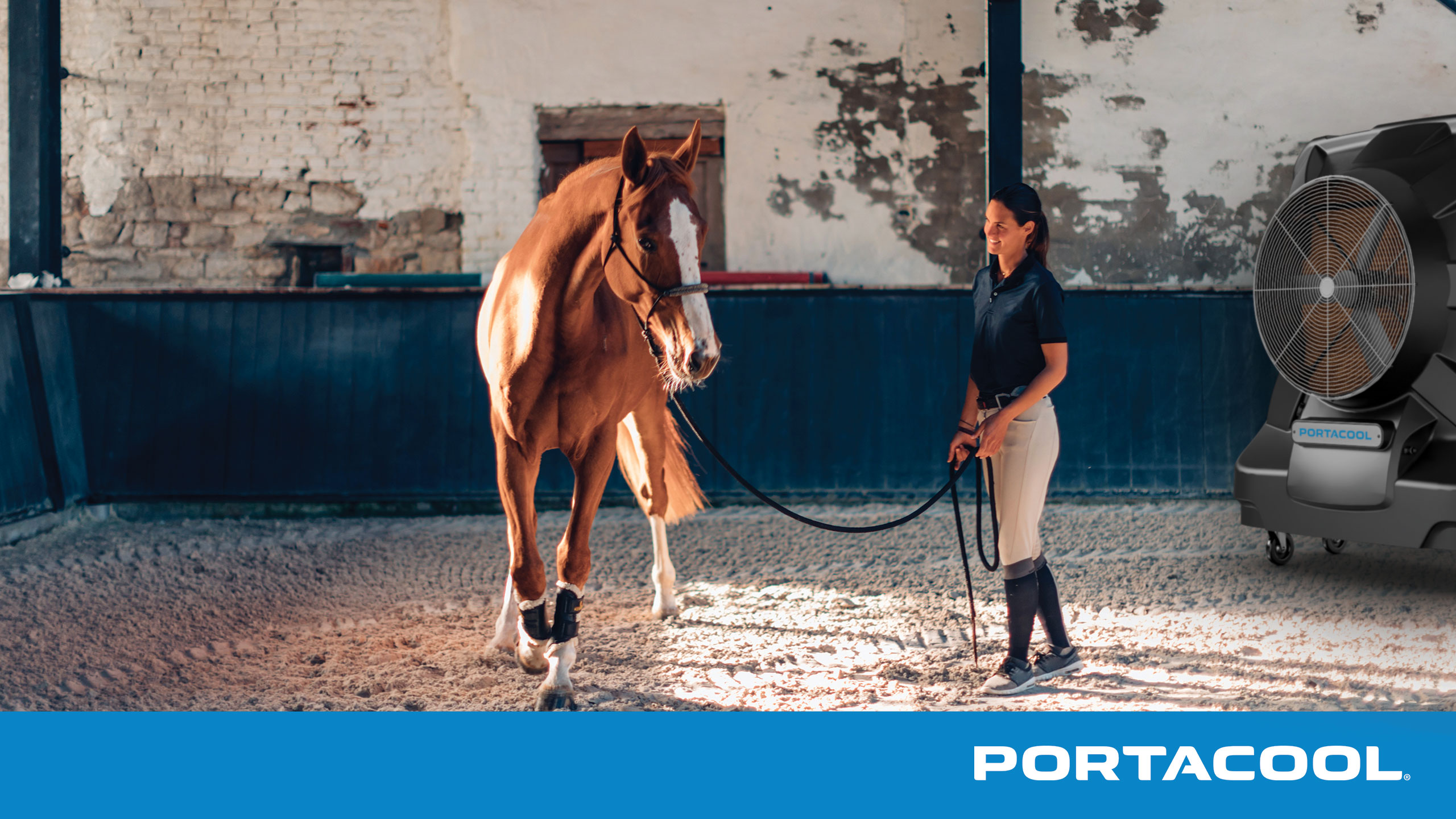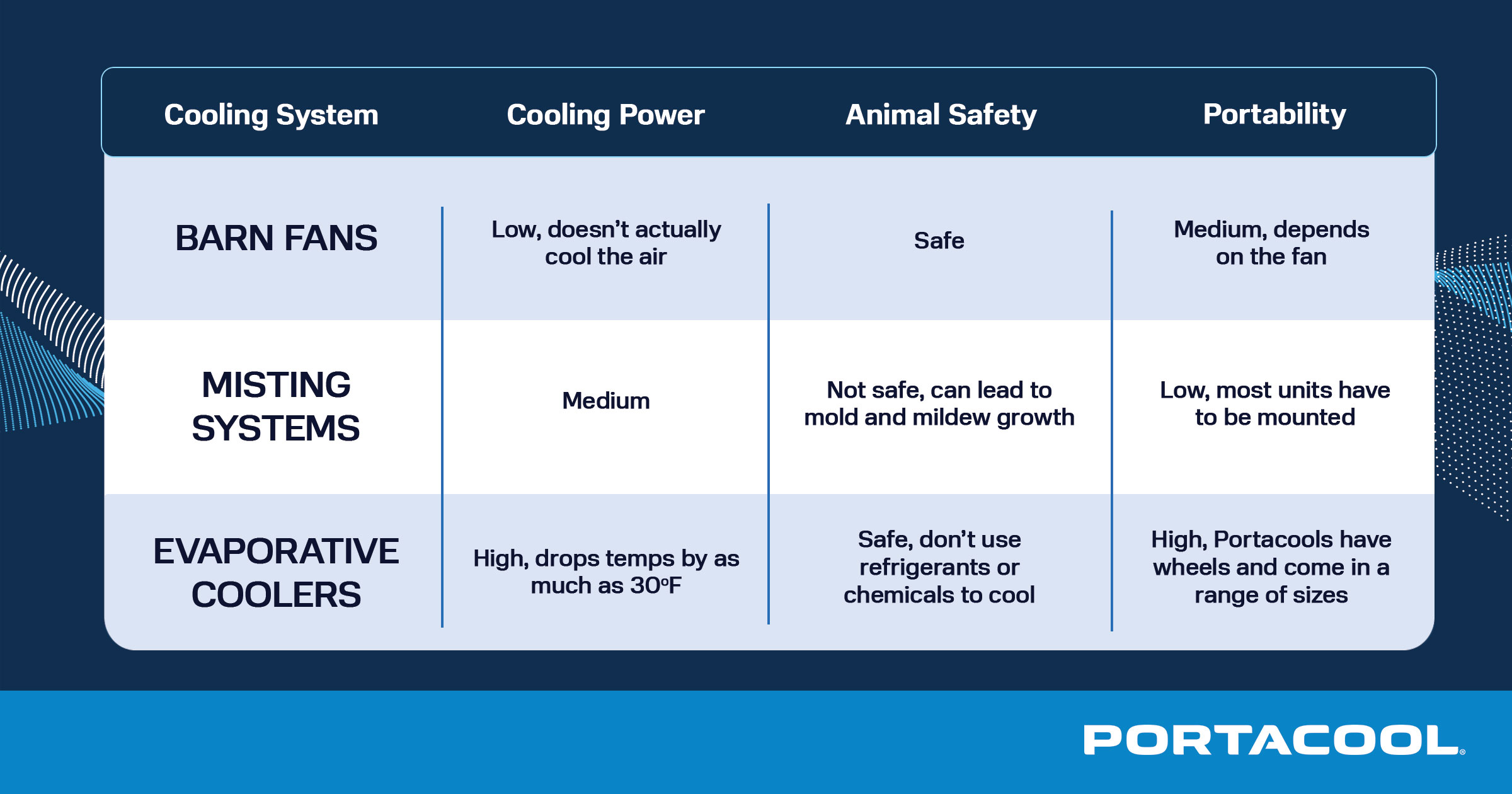- Automotive
- Aviation
- Building & Construction
- Corporate
- Corrections & Prison Systems
- Evaporative Cooling
- Farm & Agriculture
- Home & Residential
- Hospitality & Dining
- Military & Government
- News
- Outdoor Work Applications
- Pets & Animals
- Safety
- Small Business & Trades
- Sports & Outdoors
- Warehouse & Industrial
Cooling Solutions for Equine Facilities: Protecting Horses from Heat Stress

Horses hate the heat, just like us. Imagine standing in a hot barn or stable all day long in the blistering summer sun. The heat tires you out, makes you dehydrated, and puts you at risk for dangerous medical conditions. While you can walk back into your air-conditioned house and get a cold drink, your horse can’t cool down as easily. Furthermore, its body composition makes it easier for it to heat up, and harder to cool down.
Fortunately, you can use a powerful barn cooling system like portable evaporative coolers for horses comfortable and safe. In this blog, we’ll show you how to recognize signs of heat stress in horses, treat it, and prevent it with effective equine facility cooling solutions.
Do horses get heat stress?
Like humans, horses can develop serious heat-related medical conditions. Yet horses are at a greater risk for heat stress due to their body composition. They have less surface area relative to their mass, so they don’t have enough skin to adequately cool themselves down through sweating. This means that by the time you start feeling hot, your horse has already been feeling hot for a while. Humans can handle exercising in the heat for up to 10 times longer than horses.
A horse’s regular body temperature should be between 98-101ºF. Horse heat stress, also known as heat exhaustion, occurs when a horse’s body temperature rises to 102ºF or greater due to excess heat. If left untreated, it can progress to equine heat stroke or even death.
Signs of heat stress in horses:
- Excessive sweating or less sweat than expected
- Very hot or very cold skin
- Muscle weakness and fatigue
- Stumbling
- Rapid breathing
- High heart rate that doesn’t recover after exercise
- Increased body temperature of 102-106ºF
- Dehydration or signs of it, like cessation of urination, sunken eyes, loss of skin elasticity
How to treat heat stress in horses
If you suspect that your horse is developing heat stress, stop all physical activity and try to cool your horse down using the tips below. If your horse is still showing signs of equine heat exhaustion after 20 minutes of cooling, take it to a veterinarian for medical care.
How do I cool down a horse?
To cool down a horse, follow these steps:
- Stop all exercise and move your horse to a shaded, cool area.
- Gradually wet the horse with cool—not cold—water.
- Fans can help, passing air over the horse’s wet skin for a small cooling benefit.
- Help the horse stay hydrated by giving it a small amount of drinking water every 15 minutes.
When it comes to heat exhaustion, prevention is the best medicine. Use methods like evaporative cooling systems for stables to protect horses during the summer months and protect them from long-term health risks associated with heat.

What are the best ways to cool equine facilities?
Uncooled equine facilities put horses at risk for heat stress in barns and stables. Confined spaces trap the horses’ body heat and can make indoor temperatures hotter than outside temperatures.
To keep horses healthy and comfortable all summer long, invest in effective barn and stable cooling systems.
Horse barn fans
Once the air temperature gets above 75° F, fans start to lose their cooling effectiveness for animals. Horse stall fans only circulate air, not cool it. The cooling effect actually comes from sweating, a natural form of evaporative cooling. Circulating air can make sweating more effective, but only up to a point.
A University of Kentucky study confirms that fans have little impact on the air temperature in a barn. When researchers attempted to use box fans to direct air either into or out of the stall, the temperature was even hotter – about 3.5° F above outside air temperatures. The study concluded that “without an active air conditioning or evaporative cooling system, it is not possible to truly cool a barn or stall with a fan.”
Barn misting systems
Misting systems combine fans and water to provide a cooling effect. This combination makes misters a better cooling option than barn fans. However, misting systems also release a lot of water into the air, which lands on hay and leads to issues with mold and mildew in barns. While this helps prevent horse heat stress, barn misting systems can create other health problems by exposing your animals to mold and mildew.
Evaporative cooling for barns
Evaporative cooling is a natural, animal-safe option for equine facilities. Portable evaporative coolers, also known as swamp coolers, take in hot air, pass it through water-soaked evaporative media, and then release the cooled air back into the environment. This process can reduce air temperatures by up to 30ºF.
Since they only need water and electricity, and don’t use any toxic chemicals or refrigerants, evap coolers are a great choice for keeping horses cool. They also use minimal electricity, making them a more eco-friendly and cost-effective horse barn cooling system than traditional air conditioning.
Comparing barn cooling methods

Portacool evaporative coolers are the best choice for keeping horses cool
Horse breeders, equestrian trainers, and veterinarians trust Portacool barn cooling systems to deliver unparalleled cooling for their animals, all year long. Our APEX™ Series come in a variety of sizes to cool anywhere from small stables up to large equine facilities.
Dave Archer show horses
Equestrian trainer Dave Archer relies on Portacool evaporative horse barn coolers to keep his horses cool and comfortable. His large facility includes: 41 stalls, a 200’ x 120’ outdoor riding area, a 60-foot round pen, a large pasture and five turnouts (two large, three small).
About using Portacool evap coolers to keep his barn cool, he said, “When we place the Portacool in the alley way, we can easily get a 15°F drop and keep it cool in a manageable way. It’s important we keep our clients’ horses safe from the negative effects of heat and the Portacool evaporative cooler allows us to do that.”
Protect your horses with Portacool
With Portacool barn evaporative coolers, your horses can stay cool and comfortable all summer long and beyond. Protecting your horses from excessive heat helps them stay healthy and perform at their best. Our APEX coolers are designed with animal comfort, safety, and operational efficiency in mind.
The hot season isn’t over yet. Contact your local Portacool dealer to learn more about cooling barns, stables, and equine facilities with the best evaporative coolers for horses.